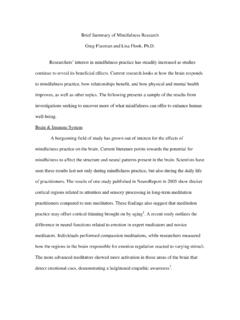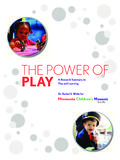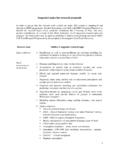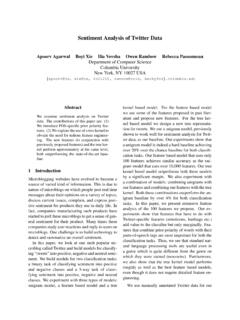Transcription of Adolescent Suicide Attempters: Latest Research & Promising ...
1 Adolescent Suicide Attempters: Latest Research & Promising InterventionsCharlotte Haley, Jennifer L. HughesTexas Suicide Prevention SymposiumJune 10, 2010 Suicide : The Numbers The 3rd leading cause of death in youth ages 15-19 In 15-24 year olds, males are times more likely to die by Suicide than females. In the general population.. 9% of teens have made an actual Suicide attempt 19% of teens have reported suicidal ideation In teens with depression.. 35-50% of depressed teens have made a Suicide attemptSuicidal Ideation & Attempts:Continuum of Suicidal Behavior Frequent thoughts of Suicide best predictor of Suicide attempt (Kienhorstet al.)
2 , 1990: 9,393 students; Netherlands) Most Suicide attempters report history of suicidal ideation (Oregon Adolescent Depression Project; OADP; Lewinsohnet al., 1996) females malesLifetime Suicide Attempt History:Continuum of Suicidal Behavior In community study of 16,000 adolescents, multiple attempts assoc. with health risks (Rosenberg et al., 2005): Heavy alcohol use/hard drug use Sexual assault, Violence History of Suicide attempts common among adolescents who die by Suicide 44% (Brent et al., 1988) 34% (Marttunenet al.
3 , 1992)Suicidal Ideation & Attempts:Continuum of Suicidal Behavior Outcome of adolescents hospitalized following Suicide attempts Males Suicide (5 years; Kotila, 1992) Suicide (4-to 10-years; Motto, 1984) Suicide (10-15 years; Otto, 1972) Females Suicide (5 yr follow-up; Kotila, 1992) At greatest risk in first three months after attempt, and approximately 30% of Adolescent Suicide attempters reattempt within 1 year (Bridge et al., 2006)Psychopathology Depressive /Bipolar disorder Alcohol/Substance use problems Conduct Disorder (pattern of aggressive impulsivity) Depressive Disorders in Youth and Suicidality 85% report significant suicidal ideation.
4 32% attempt Suicide by late adolescence Past Suicide attempt and current depressive disorder strongest predictors of future Suicide attempt 1/2 Adolescent male Suicide victims and 2/3 female Suicide victims suffered from depressive disorderAlcohol/Substance Abuse in Youth and Suicidality Adolescents with alcohol abuse/dependence nearly 7X more likely to attempt Suicide than others (OADP; Andrews & Lewinsohn, 1992) Alcohol abuse predicts eventual Suicide in 5-yr follow-up of hospitalized attempters (Kotila, 1992) Recent alcohol ingestion common in Suicide (28%, Hoberman& Garfinkel, 1988; 51%, Marttunenet al.)
5 , 1991)Antisocial Behavior, Aggression, Impulsivity, and Suicidality Psychological Autopsy Studies of Completed Suicide adolescents displayed antisocial behavior during year (Marttunen et al., 1992) 70% adolescents had a history of antisocial behavior (Shafii et al., 1985)Social/Interpersonal Factors: Precipitants Interpersonal conflict/loss is most common precipitant of death by Suicide (Martunnen et al., 1993) Interpersonal conflict/loss and legal/disciplinary problems relate to Suicide attemptsSocial/Interpersonal Factors:Social Support In large nationally representative longitudinal study (ADD Health; Bearman & Moody, 2004): social isolation and intransitive friendships were predictors of suicidal ideation for girls a tightly networked school community was protective against Suicide attempts for boys.
6 In study framed by Durkheim s theory (ADD Health; Haynie et al., 2006): Girls who recently moved 60% more likely than other girls to report Suicide attempt also more victimization, less school attachment, and more social isolation. Social/Interpersonal Factors:Family Support In clinical studies, family environment characteristics predict suicidality: Global family dysfunction related to severity of suicidal thoughts --mediated by adolescents psychopathology (Prinsteinet al., 2000) Suicidal Adolescent inpatients with mood disorders: less perceived family support than non-suicidal inpatients with mood disorders and non-patient adolescents (King, Segal, Naylor, & Evans, 1993) Suicidal Adolescent inpatients with less family support more likely to attempt Suicide in 6 months following hospitalization (King et al.)
7 , 1995). Gay, Lesbian, Bisexual (GLB) Youth General Population Surveys (Garofalo et al., 1998; Remafedi et al., 1998) 42% GLB Youth: Suicidal Ideation past year 28% GLB Youth: Suicide Attempt past year Unique Risk Factors Stigmatization, discrimination Double Bind: Disclosure vs. NondisclosureAvailability of Means: Firearms Firearms used by male Suicide victims; female Suicide victims (McIntosh, 2000) Availability of firearms in home differentiates Adolescent Suicide victims ( ) from hospitalized suicidal adolescents ( ) (Brent et al.
8 , 1998)Risk factors for Suicidality Current or lifetime psychopathology (mood disorders most common) History of previous attempts or self-injurious behavior Hopelessness Impulsivity Lack of affect regulation Poor problem-solving skills Social skills deficits Hostility and aggression Drug or alcohol abuse High situational stress Parental psychiatric conditions Family discord, neglect, or abuse Availability of lethal agents Brent et al. (2000) found that Suicide completion risk is increased if family has a handgun in the home Suicide ContagionProtective Factors Positive relationship with family Positive connection between child and school.
9 Adult and work Academic success Pro social peer group Religious affiliation Fair number of reasons for living Future goals Treatment ComplianceCognitive Behavior Therapy for Suicide Prevention(CBT-SP)Developed in Treatment of Adolescent Suicide Attempters Study (TASA)Treatment of Adolescent Suicide Attempters (TASA) Study A multi-site NIMH-sponsored study of depressed suicidal adolescents Ages 12-18, with depression (MDD, Dysthymia, or Depression-NOS) and a Suicide attempt within past 90 days Treatment: medication alone vs.
10 CBT alone vs. medication and CBT (randomization vs. choice) A feasibility studyInvestigators for TASA NIMH (Ben Vitiello, Ann Wagner, Joanne Severe) Columbia / NYU (Larry Greenhill, Barbara Stanley, Kelly Posner, Barbara Coffey, J. Blake Turner) Dallas (Graham Emslie, Betsy Kennard, Taryn Mayes) Duke (Karen Wells, John Curry, John March) Johns Hopkins (John Walkup, Mary Cwik, Mark Riddle) Pittsburgh (Oscar Bukstein, David Brent, Tina Goldstein, Kim Poling) Consultants (Greg Brown (Penn), David Goldston (Duke)Why Study the Treatment of Adolescent Suicide Attempters?)









